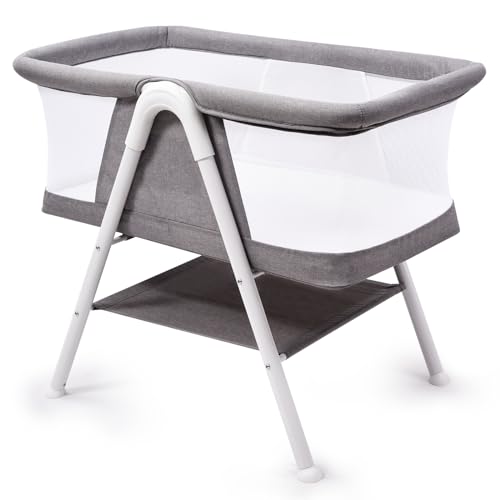The No. 1 Question That Anyone Working In Bedside Cot That Attaches To Bed Should Know How To Answer

The Modern Bedside Cot: A Comprehensive Guide to Bedside Cots That Attach to Beds
In today's fast-paced world, parenting has progressed significantly, with the focus on developing a safe and comfortable environment for infants and young children. Among the significant improvements in this world is the bedside cot, a versatile solution that parents can use to keep their newborns close, especially during the important early months. Bedside Cot For Healthy Sleeping explores the advantages, functions, and factors to consider of employing a bedside cot that attaches to a bed.
What is a Bedside Cot?
A bedside cot, often referred to as a co-sleeper or sidecar crib, is a specially created crib that links to a parent's bed, providing an available sleeping space for infants. These cots provide the convenience of co-sleeping while preserving a different sleeping environment for the kid.
Secret Features of Bedside Cots
- Security Standards: Bedside cots are created to adhere to high safety requirements, guaranteeing that there are no spaces in between the cot and the parent's bed, hence reducing the risk of entrapment.
- Adjustable Height: Most bedside cots come with adjustable height settings, enabling them to line up completely with the parents' bed mattress.
- Convenience: Having the baby within arm's reach can assist with nighttime feedings and comforting, lessening the requirement for parents to completely wake up.
- Mobility: Many designs are lightweight and easily foldable, making them best for travel or for families with restricted space.
Advantages of Using a Bedside Cot
The bedside cot uses multiple advantages, consisting of:
- Enhanced Bonding: The close proximity fosters emotional bonding and security for both the baby and the parent.
- Relieve of Feeding: Breastfeeding mothers can easily access their babies for nighttime feeds without needing to get out of bed.
- Promotes Safe Sleep: Parents can monitor their kid's sleeping patterns and breathing closely, reducing stress and anxiety.
- Convenient Access: Parents can rapidly and easily relieve or address their baby without totally awakening.
Choosing the Right Bedside Cot
With numerous options offered in the market, it is vital to think about numerous elements when choosing a bedside cot:
1. Security Features
Constantly examine for safety certifications, including compliance with relevant requirements. Guarantee the cot has features such as:
- Sturdy frame
- Anti-tipping design
- Safe and secure attachment mechanism
2. Product and Construction
The material needs to be non-toxic and safe for infants. Select cots made from natural wood or high-quality licensed materials. Also, check that the mattress is firm and fits snugly within the cot to prevent any hazards.
3. Size and Compatibility
Think about the size of your bed and the available space in your bedroom. Bedside cots are available in numerous sizes, so make sure to pick one that fits conveniently together with your bed without blocking movement.
4. Mobility
If you plan to transfer the cot often, try to find light-weight options with wheels or collapsible designs for easy transportation.
Popular Bedside Cots on the marketplace
| Bedside Cot Model | Secret Features | Cost Range |
|---|---|---|
| Chicco Next2Me | Adjustable height, breathability mesh, foldable. | ₤ 200 - ₤ 250 |
| BabyBjörn Cradle | Light-weight, natural materials, easy to move. | ₤ 299 - ₤ 349 |
| Arm's Reach Concept 2 | Easy to attach/detach, security strap, mattress consisted of. | ₤ 150 - ₤ 200 |
| Dream On Me Co-Sleeper | Lightweight, portable, various color options. | ₤ 150 - ₤ 180 |
Often Asked Questions (FAQs)
1. Is a bedside cot safe for my baby?
Yes, as long as it meets security requirements and is used correctly. Always guarantee the cot is safely connected to your bed with no spaces.
2. At what age can my baby use a bedside cot?
Many bedside cots appropriate from birth until the kid can stay up independently or when they start to move around, generally around 5-6 months.
3. Can I use a regular crib as a bedside cot?
Requirement cribs, while large, are not designed to connect to beds and typically lack the security features that bedside cots offer. It is best to use a cot particularly developed for this purpose.
4. How do I clean up a bedside cot?
Most models have removable, washable material covers, while wood frames can be cleaned down with a damp fabric and mild soap.
5. Are there any drawbacks to using a bedside cot?
While they are convenient, they may not be ideal for all households. Some parents might find they choose a separate crib for comfort or if their infant has sleep disruptions.
Bedside cots that connect to beds offer a distinct and convenient option for modern parents desiring to keep their infants close during the night. They open doors to much safer co-sleeping options, motivate bonding, and simplify nighttime routines. With the range of models available, parents need to carefully consider their private needs and preferences, together with security features and ease of use, to pick the ideal bedside cot. As parenting continues to progress, bedside cots represent an unified blend of tradition and innovation in fostering a nurturing environment for new households.

